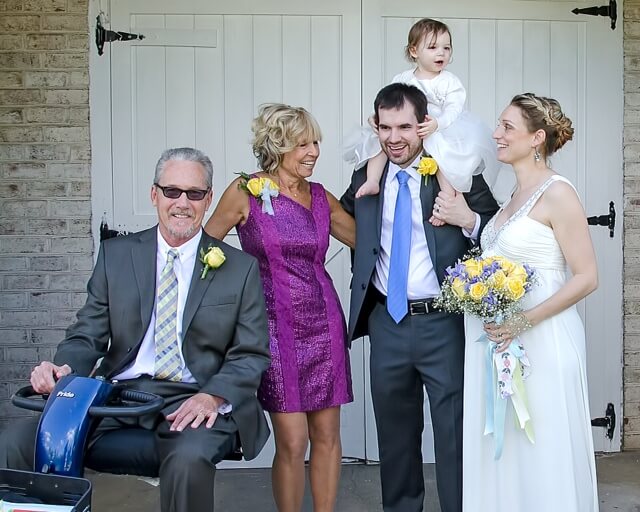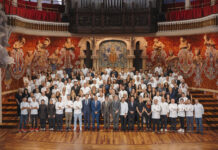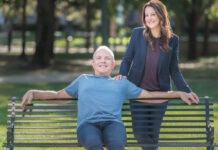Happy Moments Amidst Advanced Disability: Part 2 of 4
By Greta Salmi
Once my husband needed help with everyday life activities, our learning curve was steep. The emotional toll of being a spousal caregiver for someone with Muscular Dystrophy made our happy marriage take a big hit. We didn’t give up on each other and it wasn’t an easy journey.
Knowing that Muscular Dystrophy was a downward slope, we planned many family trips. During our last trip to Italy and Greece, we visited spots bathed in sun and warmth to counter the Seattle weather. The old structures, cobblestone streets, and lack of curb cuts made walking around difficult. Still, we managed and loved the time we had. The girls and I could climb to the top of the St. Peter’s Dome by the Vatican while our sons would goof around with Joel. Later, the boys would race to the top of the Spanish Steps while our daughters and I hung with Joel. These family memories have sustained us all.
Advertisement
The Heart of the Caregiver: From Overwhelmed to Overjoyed
In 2006, we moved to Palm Springs and Joel started commuting to Seattle one week out of three to work in his law office. I felt that the desert climate would dry the Seattle dampness off me, and the rain or ice-slicked Seattle sidewalks could make life perilous for Joel. Grudgingly, painfully, Joel became scooter bound that same year. He didn’t want to be seen practicing with a scooter, so he learned how to maneuver in desolate parking lots until he had the confidence to be seen in one.
One time, a man who I thought was ogling me, approached Joel and asked intensely about his scooter. It was scooter envy and there was nothing flirtatious about it. Little boys were also curious about Joel’s “motorcycle.” What had started as an embarrassment was becoming a magnet. For a man who was used to getting a lot of attention for his looks, it was another setback. This disease was not a hit by-a-truck experience. It rolled him slowly down the hill with no brakes.
We continued on, having mostly happy moments. We entertained for my school staff, and cooked fabulous dinners for friends. With his scooter, Joel and I could move side by side again, watching the red skies of desert sunsets and taking the tram to the top of the Palm Springs mountains, where we could watch a full moon rise. Our children visited often, lured by our swimming pool and warm winters.
Advertisement
The Engaged Caregiver: How to Build a Performance-Driven Workforce
to Reduce Burnout and Transform Care
We listened to jazz and ate at restaurants when they weren’t too crowded for a scooter. Occasionally, a restaurateur would want to hide us in the back of their establishment. But we found plenty of delightful, welcoming places. We were working so hard to figure it all out, but the game kept changing. One day in 2010, after four years of using his scooter, Joel pushed and pulled and finally looked at me with disbelief. “I can’t do it,” he cried. “I can’t stand up!” It was another moment when I realized that the future would be much more difficult than what I had imagined.
Lifestyle Changes
That same year, Joel realized that he could no longer travel alone and be in Seattle by himself safely. We had some enormous decisions to make. I could continue to work and Joel could retire, or I could retire and travel with him, which would allow him to continue to work part-time. We did the math. He made more working part-time than I made working full-time as the Director of Elementary Education for Palm Springs, so I agreed to retire early and travel with him.
I changed emotionally, accompanying him back and forth to Seattle for a week or so at a time. In many ways, my job had defined my identity. I had to figure out how to be back in the city where I had been a school principal for six years. Now, I was unsure of myself. Was I a medical caretaker or a wife who supported her husband’s career? Were either of these roles enough? I hiked. I read. I remember walking into a dry cleaner one day and feeling envious of the people who worked there. They had work colleagues and a work identity. I felt adrift. I couldn’t volunteer, as our time in Seattle was so sporadic. I felt selfish complaining in the face of the towering losses Joel faced. In time, I worked as a consultant in a few schools. This helped tremendously. I needed the self-esteem.
When you are in the middle of something, you never know if it’s the beginning, the middle or the end. At least I didn’t. By 2007, the issues multiplied. Joel now needed assistance with dressing, showering and preparing food. At first, I did things exactly the way Joel wanted, at least around the MD, both for his comfort and for his sense of autonomy. We argued over so many little things; I painfully learned not to underestimate the need for a disabled person to be in control.
Advertisement
Perrier Fusions, Assorted Flavors, 11.15 Fl Oz Cans (Pack of 18)
I used to joke that a lawyer’s three favorite words to hear are not “I love you,” but rather, “You are right.” I tried to say that sincerely and often to my husband. But soon, I needed to exert my wishes.
“Look,” I would grimace. “Those shirts are hell to put on. Can’t we find something that works for you and is easier on my part?” Ross for Less became my new friend; Nordstrom an enemy. Finding clothes for Joel on my own became a new game, as shopping together became more acrimonious. He wanted clothes that were stylish and durable; I selected clothes that had a shelf-life of months instead of years, as the increasing lack of mobility quickly made clothes obsolete.
For Joel, putting on pants meant that I would position them while he was lying down in bed, then lift his legs up in the air and pull the pants over them. Then, he carefully pulled and guided his weight to the bed’s edge, using the transfer board to slide him over to the scooter seat. Once there, he moved to the toilet, and then to the sink for teeth cleaning and shaving. There was no hurrying. To tell Joel or any disabled person to hurry is like dumping wet concrete on them. Everything takes longer as the push to hurry slows down muscle function.
My husband loves to cook. He reads cookbooks and becomes Italian when he makes Pasta Puttanesca, Mexican when he makes Mexican rice. But by age fifty-eight, seventeen years into the diagnosis, he couldn’t hold things, open cans, pull lids off containers, even open the refrigerator. Initially, I thought he wasn’t trying and that he simply wanted me to do more for him. Of course, this wasn’t the case; he just couldn’t do it.
I needed to become his arms and hands. The afternoon he told me to “take off the lid and stir the soup” put me over the top. Did he think I would try and stir through the top? “Why don’t you hire someone to be your hands so you can boss them around instead of me?” I asked.
“Can’t you just help me without complaining?” he replied. I was not sure that I could. More than once, I sat in my car, returning from wherever, and cried, steeling myself to go in and try to be the cheerleader who helps without complaint. Our fights sometimes sent Joel into the huge walk-in closet in our bedroom to mask his screams and tears. I wanted desperately to fix this, but I couldn’t.
Fortunately, I found a marvelous counselor who helped me sort things out. Joel said he would go with me to talk to him. Upon meeting David, who had a birth defect that left him with fewer fingers on each hand, and some walking issues as well, Joel asked, “Did you pick a counselor who is disabled to demonstrate to me how to cope?” After first noticing David’s disability, I never thought about it again. I went back alone to see David many times. We cope in different ways.
Joel was still able to transfer to the bed, the shower seat, and the toilet, though he required help. For a time, we used transfer boards, smooth pieces of crafted wood that a person can skootch onto, and slowly slide over to the next safe harbor, such as a toilet seat or a bed. Joel’s determination was amazing. I cheered him on through his struggles.
Along with diminished strength came the stiffness of the ankle joints that eventually made his feet unable to move, making regular shoes impossible. We bought a pair of light and expensive slip-on Italian loafers, which became too heavy to wear after a few months. Heavy shoes meant Joel couldn’t move his legs on the scooter floorboards, which was necessary for comfort. So now it was cheap, lighter shoes or just sandals. Fashion be damned.
When presented with such a disability, most men do their best to hide it from the world. This was true for Joel, although he could confide in a few dear friends. The world thought he was incredibly upbeat and brave, which he was and is, but the world doesn’t witness the very sad moments, and that has been isolating for us. It means I am the only person to deal with his pain.
My girlfriends provided a posse of support. Elaine offered to be the listening ear to the many seemingly impossible moments in our lives. “It’s OK,” she would say. “You can vent. It won’t get me down.” What a gift. I couldn’t have blamed them if they had told me to buck up. After all, I didn’t have the disease; Joel did.
Getting Help
Slowly, Joel gave up some of his intense need for control. Frank Lloyd Wright, they say, would come into a room and slightly move a lamp or rearrange the roses on a table to make a room look better. That is my husband. Only now, I became the person moving the chair, or straightening the picture. At his request. At some point, Joel learned to care less about the patterns of the vacuum or exactly how high the shades were raised. It was another loss for Joel but for me, it was a small step toward maintaining mental health. This isn’t paid help; I am his wife.
Fortunately, we had financial resources. We could afford the specialized scooters that allowed him to move up and down on his seat. He tried orthotic shoes and leg braces. They lasted barely a moment. Shirts in plus sizes billowed on his frame and allowed easier access for arms that were becoming increasingly difficult to raise. It seemed a bit foolish to always search for new things to help, but it seemed fatalistic to give up trying. Dockers and blue jeans — too difficult to pull up. Warm-up pants with slippery fabric became Joel’s latest fashion statement. Joel’s preferred suits, dress slacks, and fancy shoes, impossible to put on, remained in the closet.

Six years ago, we flew for the last time together, for our daughter’s wedding. I will always be grateful that Joel could attend. Even then, people forgot he was disabled because he is still funny and witty and charming and handsome. Joel was what he liked to call “deceptively disabled.” During that trip, airport security would ask him if he could just “get up and walk through the check point” because he didn’t look disabled. Some people thought he was faking it. I could see the eye-rolling and exasperated looks, but frankly, Joel needed the help of airport assistants to get in and out of his aisle seat. One short, strong guy told us, “Don’t worry, I got this.”
I held my breath as he picked Joel up by the waist and muscled him into the seat. I thought we were all going to be sprawled in the aisle but luckily, he made the transfer. Of course, that meant no trips to the bathroom on the six-hour flight. We were creative in our use of lap blankets and hand-held urinals, but we both knew his flying days were numbered.
GRETA SALMI lives with her husband, Joel, in the S.F. Bay Area. She coaches educators and was a school principal for nineteen years. She can be reached via Twitter, @GretaSalmi.

































